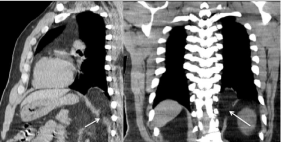
Clinical Image
Austin J Radiol. 2021; 8(4): 1137.
Fortuitous Discovery of a Bochdalek Hernia in an Adult
Khadija L*, Hajar A, Jamal EF and Issam E-N
Department of Radiology, Mohammed V Military Teaching Hospital, Faculty of Medicine and Pharmacy, Mohammed V University, Rabat, Morocco
*Corresponding author: Laasri Khadija, Department of Radiology, Mohammed V Military Teaching Hospital, Faculty of Medicine and Pharmacy, Mohammed V University, Rabat, Morocco
Received: May 14, 2021; Accepted: June 08, 2021; Published: June 15, 2021
Keywords
Diaphragmatic hernia; Bochdalek hernie; Adult
Clinical Image
Bochdalek hernia is the most common type of congenital diaphragmatic hernia. It is due to a defect in the posterior attachment of the diaphragm muscle, subsequent to a failure of pleuroperitoneal membrane closure in utero.
Bochdalek hernia is often asymptomatic in adults, hence, it is fortuitously discovered as an incidental finding on CT scan. Alternatively, it may be diagnosed only after complications occur, such as empyema, cardiac tamponade and gastrointestinal strangulation.
CT usually demonstrates a fatty mass above the diaphragm (Figure 1: arrow), which may be associated with other organs entrapment. Coronal and sagittal reformatted images show the diaphragmatic defect (Figure 2: arrows).

Figure 1: Axial abdominal CT scan image showing a left sided fat containing
Bochdalek hernia (arrow).
